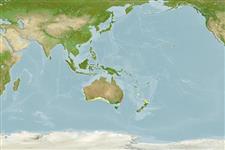>
Gobiesociformes (Clingfishes) >
Gobiesocidae (Clingfishes and singleslits) > Cheilobranchinae
Etymology: Cochleoceps: Greek, kochlea = snail like + Latin, ceps, caput = head (Ref. 45335).
Environment: milieu / climate zone / depth range / distribution range
Écologie
marin démersal; profondeur 3 - 40 m (Ref. 9002). Subtropical
Southwest Pacific: New South Wales and eastern Victoria, Australia.
Taille / Poids / Âge
Maturity: Lm ? range ? - ? cm
Max length : 5.5 cm TL mâle / non sexé; (Ref. 9002)
Description synthétique
Morphologie | Morphométrie
Épines dorsales (Total): 0; Rayons mous dorsaux (Total): 5-6; Épines anales 0; Rayons mous anaux: 4 - 6. Caudal fin rounded (Ref. 9002). Pelvic fins united into moderate-sized double sucking-disc, posterior half with a fleshy fringe (Ref. 9002). Greenish-yellow to orange with small scattered dark spots to larger red spots, variable in density; iridescent blue dashes or lines dorsally and across sides over head and body (Ref. 9002).
Adults usually on kelp, on which they deposit their eggs, which are guarded by the male, although the female is often present as well (Ref. 9002). Often on ascidians or sponges in deep water, probably depositing eggs on algae nearby (Ref. 9002). Often observed cleaning boxfishes, porcupine fishes and morwongs (Ref. 9002).
Life cycle and mating behavior
Maturité | Reproduction | Frai | Œufs | Fécondité | Larves
Kuiter, R.H., 1993. Coastal fishes of south-eastern Australia. University of Hawaii Press. Honolulu, Hawaii. 437 p. (Ref. 9002)
Statut dans la liste rouge de l'IUCN (Ref. 130435)
Menace pour l'homme
Harmless
Utilisations par l'homme
Plus d'informations
PaysZones FAOÉcosystèmesOccurrencesIntroductionsStocksÉcologieRégime alimentaireÉléments du régime alimentaireConsommation alimentaireRation
Noms communsSynonymesMétabolismePrédateursÉcotoxicologieReproductionMaturitéFraiRassemblement de ponteFéconditéŒufsDéveloppement de l'œuf
Taille/ÂgeCroissanceLongueur-poidsLongueur-longueurFréquences de longueursMorphométrieMorphologieLarvesDynamique des populations larvairesRecrutementAbondanceBRUVS
RéférencesAquacultureProfil d'aquacultureSouchesGénétiqueElectrophoresesHéritabilitéPathologiesTraitementNutrientsMass conversion
CollaborateursImagesStamps, Coins Misc.SonsCiguateraVitesseType de nageSurface branchialeOtolithesCerveauxVision
Outils
Articles particuliers
Télécharger en XML
Sources Internet
Estimates based on models
Preferred temperature (Ref.
123201): 16.4 - 23.3, mean 18.2 °C (based on 72 cells).
Phylogenetic diversity index (Ref.
82804): PD
50 = 0.5312 [Uniqueness, from 0.5 = low to 2.0 = high].
Bayesian length-weight: a=0.00389 (0.00180 - 0.00842), b=3.12 (2.94 - 3.30), in cm total length, based on all LWR estimates for this body shape (Ref.
93245).
Niveau trophique (Ref.
69278): 3.2 ±0.3 se; based on size and trophs of closest relatives
Résilience (Ref.
120179): Haut, temps minimum de doublement de population inférieur à 15 mois (Preliminary K or Fecundity.).
Fishing Vulnerability (Ref.
59153): Low vulnerability (10 of 100).
Nutrients (Ref.
124155): Calcium = 282 [138, 664] mg/100g; Iron = 1.45 [0.79, 2.77] mg/100g; Protein = 17.3 [16.2, 18.5] %; Omega3 = 0.332 [0.174, 0.648] g/100g; Selenium = 14.9 [6.4, 39.9] μg/100g; VitaminA = 47.7 [12.5, 172.0] μg/100g; Zinc = 1.53 [0.98, 2.36] mg/100g (wet weight);
